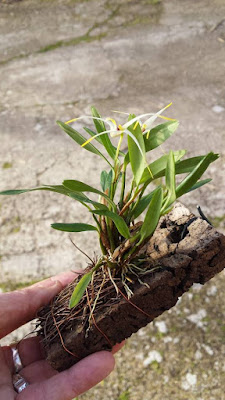Diplocaulobium chrysotropis is endemic to the north of Papua New Guinea. It grows as epiphyte on trees in mixed forests at an altitude of 1000-1300 meters...
Diplocaulobium chrysotropis also called as The Golden-Keeled Diplocaulobium, Dendrobium chrysotropis, is a species of the genus Diplocaulobium. This species was described by A.D.Hawkes in 1957.
IDENTIFY DIPLOCAULOBIUM CHRYSOTROPIS
Diplocaulobium chrysotropis is endemic to the north of Papua New Guinea. It grows as epiphyte on trees in mixed forests at an altitude of 1000-1300 meters.
It is a miniature sized, cool growing epiphyte with suberect to ascending, 5 angled, cylindrical, 3 cm long pseudobulbs carrying a single, apical, erect to suberect, ligulate to oblong-ligulate, obtuse, 3-5 cm long leaf.
The Golden-Keeled Diplocaulobium blooms in the spring and fall on a successive single flowered inflorescence. The flowers are 2.5 cm in diameter and last only 2-4 days.
DIPLOCAULOBIUM CHRYSOTROPIS CARE AND CULTURE
Cultural information should only be used as a guide, and should be to be adapted to suit you. Your physical location; where you grow your plants, how much time you have to devote to their care, and many other factors, will need to be taken into account. Only then can you decide on the cultural methods that best suit you and your plants.
Light:
Diplocaulobium chrysotropis needs a light level of 25000-30000 lux, the ideal photoperiod is 12 hours. Light is probably the most important subject for the cultivation of this orchid. One can easily understand if the orchid has enough: its new pseudobulbs are loaded and 'round', while the lack of light causes thin and elongated pseudobulbs.
Temperature:
The temperature is 22-24 ° C at daytime; night at 18-19 ° C. In its natural habitat the temperatures are more or less constant throughout the year. In autumn the most pronounced temperature change occurs between day and night (6-7 ° C), which is considered the decisive factor in stimulating the flowering of this species.
Humidity:
The Golden-Keeled Diplocaulobium needs the average humidity of 80-85% throughout the year.
Substrate, growing media and repotting:
Given its somewhat chaotic and expansive growth, the best way to grow Diplocaulobium chrysotropis is on a raft, with a little long sphagnum moss around the roots.
Watering:
During the growing period this orchid plant gets water frequently and abundantly; its roots must never remain dry.
Fertilizer:
It is recommended to use 1/4 of the indicated dose is added to the bottle of a suitable liquid fertilizer for orchids to the watering water every 7-10 days. During the rest period the orchid does not fertilize.
Rest period:
In its natural habitat there are no seasonal variations in temperature; winter is a little drier than the rest of the year, which translates into a slight rest for Diplocaulobium chrysotropis. We need to reduce watering from December to early March, but the orchid should not remain dry for a long time. A morning vaporization every 3-4 days (with air humidity equal to 80%) should suffice, however we follow the state of the plant: if the pseudobulbs start to shrivel, we need to increase the quantity of water. At the beginning of March (or as soon as we see the new jets at the base of the pseudobulbs) we increase the watering, thus marking the end of rest.

















COMMENTS